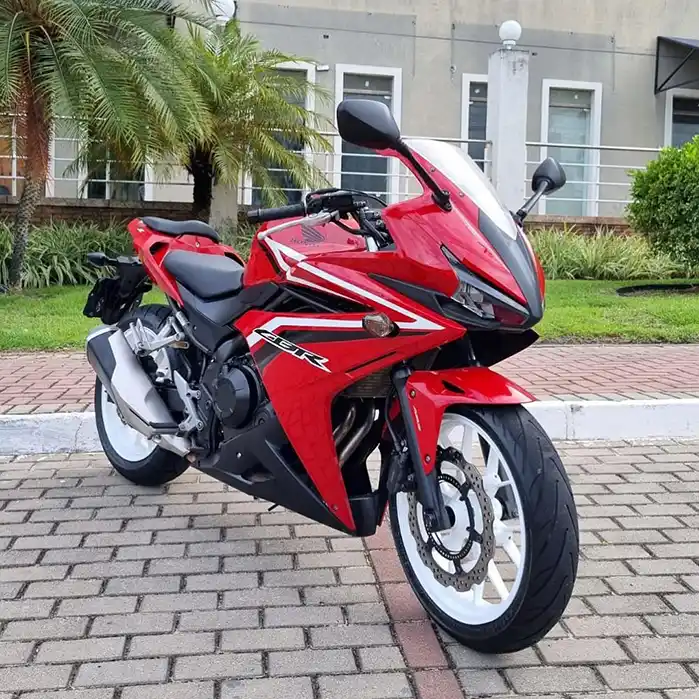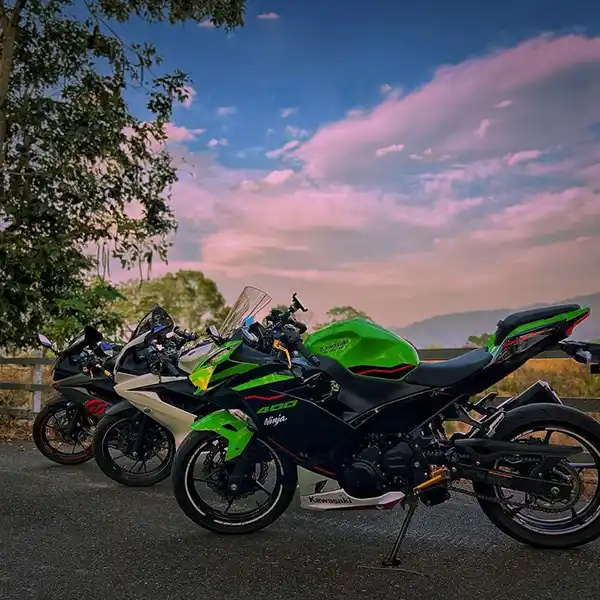While comparing the bikes, most of us are confused between Honda CBR500R vs Kawasaki Ninja 400. Both bikes are compared due to their similar engine features.
But which one to choose, Honda CBR500r vs Kawasaki Ninja 400? Choosing Honda CBR500R is more beneficial for its peak torque and it takes 4.72 seconds to accelerate. In comparison, Kawasaki Ninja 400 offers low torque and it needs 4.14 seconds to accelerate. And Honda CBR has better displacement capacity than Ninja 400.
That’s not all. There are more differences between these bikes. But don’t worry, I’ve tested both sports bikes according to their bells and whistles to help you find the right one.
Comparison Table of Honda CBR500R and Kawasaki Ninja 400
I’ve compared the most nerve-breaking specifications of the Honda CBR500R and Kawasaki Ninja 400 in this table. Let’s take a quick look.
| Specification | Honda CBR500R | Kawasaki Ninja 400 |
|---|---|---|
| Frame Chassis Material | Steel Diamond | High Tensile |
| Displacement | 471 CC | 399 CC |
| Engine type | Liquid-cooled, 4-stroke Parallel Twin | Liquid-cooled 4-stroke DOHC parallel twin |
| Transmission | 6-Speed, Manual Clutch | 6-Speed, Manual Clutch |
| Max Torque | 43 Nm @ 6500 rpm | 37 Nm @ 8000 rpm |
| Fuel Capacity | 17.1 Liters | 14 Litres |
| Horsepower | 47.5 HP | 49 HP |
| Brake | EBC – V-Pads-Semi-Sintered Brake | Kawasaki Intelligent anti-lock Brake System |
| Suspension | 41 mm Showa SFF-BP inverted forks with mono-shock with nine-step preload adjustment. | 37 mm telescopic front fork and preload-adjustable mono-shock at the rear. |
CBR500R vs Ninja 400: In-Depth Comparison
In my opinion, Honda CBR500R has higher torque than Kawasaki Ninja 400. On the other hand, Kawasaki Ninja 400 is faster than Honda CBR500R.
But you should know about additional features like engine capacity, cooling system, and top speed system when choosing between these mind-blowing sports bikes.
Engine Capacity
Honda CBR500 comprises a four-stroke and parallel twin engine similar type to Kawasaki Ninja 400. But Honda has a larger four-stroke engine capacity than the Ninja 400, making it heavier than Ninja.
Plus, Ninja 400 includes 399CC, and Honda offers 471CC. In that case, Honda dissolves more air and fuel than Ninja.
Personally, I enjoyed the engine service of Honda. It’s safer to drive a Honda on the streets. On the other hand, it’s slightly difficult to drive a Ninja 400 on busy roads at high speed due to its low rolling resistance.
Top Speed, Acceleration & Transmission
When it comes to transmission, Honda comes up with a 6-speed gear box wet multi-plate manual clutch. And it offers a 10.7: 1 compression ratio. Kawasaki Ninja provides a wet multi-disc manual clutch with 6-speed gearbox transmission. But it has an 11.5:1 compression ratio.
I’ve observed both bikes’ driving speeds at different accelerating capacities. When it comes to top speed, Honda CBR500R features 185 mph, and Ninja offers 180 mph.
I tracked the top speed and accelerated the Honda CBR from 0-60 mph within 4.72 seconds. And the Ninja 400 requires 4.14 seconds to accelerate from 0-60 mph.
So, in terms of top speed and accelerating capacity, I liked the Kawasaki Ninja 400 due to its fast acceleration on separate gears and excellent top speed.
Tires
Honda CBR500R has a 120/70/17 front tire and a 160/60/17 rear tire with 2.5 bar pressure and alloy tubeless wheels. And Ninja 400 comprises 110/70-R17 front tires and 150/60-R17 rear tires with the same bar pressure and wheels as Honda.
My riding experience and tire sizes show that Honda CBR has better rolling resistance and rolls faster than Ninja. And it’s pretty relaxing to drive Honda for the smooth and safe tires.
Bore & Stroke Capacity
The Honda CBR500R engine piston has a 66 mm stroke and a 66.8 mm bore. On the other hand, Ninja 400 engine piston comprises a 70 mm stroke, and 51.8mm bore.

Based on my experience, Honda CBR has more pumping cycles with better RPM and higher power than other sports bikes due to its short stroke and long bore.
At the same time, Ninja 400 has lower pumping cycles and engine power for the long stroke and short bore. For this reason, I definitely suggest Honda CBR.
Seat Capacity
It’s genuinely comfortable driving on a Honda CBR because it has more flexible and perfect size seats. The bike features a 785 mm seat, ensuring high comfort and safety.
On the contrary, driving an 1120 mm seat capacity is too difficult. That’s relatively higher than the average seating system. And because of it, I prefer Honda CBR to Ninja 400.
Kerb Weight
The Kawasaki Ninja 400 weighs 168 kg, whereas the Honda CBR is 192 kg. However, the weight of a sport bike can affect the speed. And I find Kawasaki Ninja 400 faster than Honda CBR due to its lightweight construction.
Brake & Suspension
Honda CBR500R comes up with the EBC – V-Pads-Semi-Sintered Brake that is dyno tested and ensures long-lasting service. Also, the semi-sintered brake pad guarantees premium organic brake pad quality.
On the contrary, Kawasaki Ninja 400 offers a personalized anti-lock brake system, giving the highest efficiency and authentic quality. Plus, it has been designed for super sports bike models.
I genuinely like the Honda brake system more because it gives me a better comfort feel than Kawasaki.
Moreover, Honda CBR500R provides 41 mm Showa SFF-BP inverted forks with mono-shock with nine-step preload adjustment suspension in the front.
The Showa SFF-BP inverted forks with mono-shock are an updated version of the conventional suspension system. On the rear suspension, it includes Pro-link Mono W/5 stage pre-load adjuster and a steel hollow cross swingarm.
Both suspension systems generate higher damping capacity, better control, and bump absorption. Kawasaki Ninja 400 has a 37mm telescopic front fork that resists needless spring motion.

And it offers horizontal back-link adjustable spring pre-load/5.1 in travel on the rear suspension for adjusting the spring mechanism horizontally and assures you of a good ride.
Technology Features
Offering advanced technology on the instrument panel, Ninja 400 will show you a crystal clear image of speed and accelerating process.
Next, it includes a 2-1 short silencer exhaust, ensuring the best performance and producing less noise. The heat management technology controls hot air by digesting it and keeps your eyes safe from extreme heat in traffic when you can’t even move your bike.
On the other side, Honda CBR500R includes programmed fuel injection for a perfect fuel mixture that helps to boost torque capacity and power. And that also reduces fuel emissions. It has an LCD instrument panel to ensure the best quality image for a better driving experience.
Besides a comfortable seat design and aluminum wheels, it provides Honda Pro-Link rear suspension technology for a flexible driving experience. After testing both bikes, I found Honda’s technology more useful than Kawasaki’s.
Considering my choices, I’ll definitely go with the Honda because it’s more comfortable and performs better than Kawasaki Ninja 400.
FAQs
Apart from the discussion above, I am answering some intriguing queries that might help you better understand the comparison between both bikes.
Q: IS THE HONDA CBR500R BIGGER THAN THE KAWASAKI NINJA 400?
Yes. It has a larger fuel tank, bigger tires, and longer body construction than Ninja 400. And Honda CBR is also heavier compared to Ninja 400. Plus, it has a lower ground clearance than Ninja.
Q: IS THE HONDA CBR500R A GOOD BEGINNER BIKE?
Yes. Honda CBR500R is a good beginner bike because it comes up with excellent seating capacity and a high-quality engine mechanism. It runs smoothly and hassle-free.
This sports bike offers outstanding features like peak torque and perfect stroke size that helps beginners to learn better on the streets.
Q: CAN PROFESSIONALS USE KAWASAKI NINJA 400?
Yes. It works better on highways. But it’s pretty hard to maintain it in competitions and long route drives. And it comes up with smooth performance. Professionals can use this sports bike for regular practice and to teach beginners.
Final Thoughts
That’s all for Honda CBR500R vs. Kawasaki Ninja 400. Personally, I loved the Honda CBR500R because it’s more stable and long-lasting than the Ninja. Plus, this sports bike has higher torque and power. Though Ninja 400 runs faster, I felt more comfortable riding on Honda CBR.
Apart from its jaw-dropping performance and durable frame chassis material, you’ll get a stylish look and design if you take Honda CBR. I also chose it for the large fuel tank containing more than 17 liters. If you are new to sports bikes, I recommend choosing Honda CBR500R.